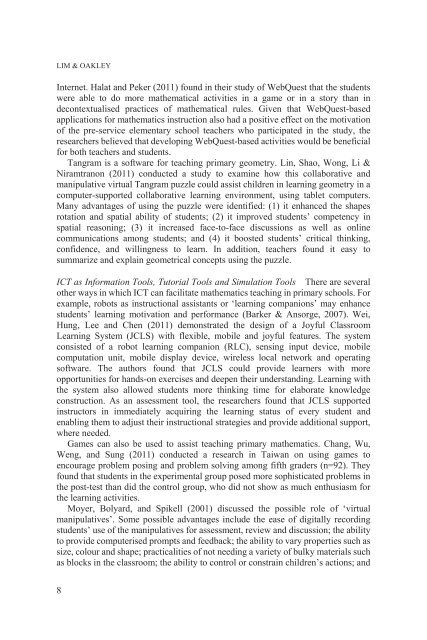1517-creating-holistic-technology-enhanced-learning-experiences
1517-creating-holistic-technology-enhanced-learning-experiences
1517-creating-holistic-technology-enhanced-learning-experiences
You also want an ePaper? Increase the reach of your titles
YUMPU automatically turns print PDFs into web optimized ePapers that Google loves.
LIM & OAKLEY<br />
Internet. Halat and Peker (2011) found in their study of WebQuest that the students<br />
were able to do more mathematical activities in a game or in a story than in<br />
decontextualised practices of mathematical rules. Given that WebQuest-based<br />
applications for mathematics instruction also had a positive effect on the motivation<br />
of the pre-service elementary school teachers who participated in the study, the<br />
researchers believed that developing WebQuest-based activities would be beneficial<br />
for both teachers and students.<br />
Tangram is a software for teaching primary geometry. Lin, Shao, Wong, Li &<br />
Niramtranon (2011) conducted a study to examine how this collaborative and<br />
manipulative virtual Tangram puzzle could assist children in <strong>learning</strong> geometry in a<br />
computer-supported collaborative <strong>learning</strong> environment, using tablet computers.<br />
Many advantages of using the puzzle were identified: (1) it <strong>enhanced</strong> the shapes<br />
rotation and spatial ability of students; (2) it improved students’ competency in<br />
spatial reasoning; (3) it increased face-to-face discussions as well as online<br />
communications among students; and (4) it boosted students’ critical thinking,<br />
confidence, and willingness to learn. In addition, teachers found it easy to<br />
summarize and explain geometrical concepts using the puzzle.<br />
ICT as Information Tools, Tutorial Tools and Simulation Tools There are several<br />
other ways in which ICT can facilitate mathematics teaching in primary schools. For<br />
example, robots as instructional assistants or ‘<strong>learning</strong> companions’ may enhance<br />
students’ <strong>learning</strong> motivation and performance (Barker & Ansorge, 2007). Wei,<br />
Hung, Lee and Chen (2011) demonstrated the design of a Joyful Classroom<br />
Learning System (JCLS) with flexible, mobile and joyful features. The system<br />
consisted of a robot <strong>learning</strong> companion (RLC), sensing input device, mobile<br />
computation unit, mobile display device, wireless local network and operating<br />
software. The authors found that JCLS could provide learners with more<br />
opportunities for hands-on exercises and deepen their understanding. Learning with<br />
the system also allowed students more thinking time for elaborate knowledge<br />
construction. As an assessment tool, the researchers found that JCLS supported<br />
instructors in immediately acquiring the <strong>learning</strong> status of every student and<br />
enabling them to adjust their instructional strategies and provide additional support,<br />
where needed.<br />
Games can also be used to assist teaching primary mathematics. Chang, Wu,<br />
Weng, and Sung (2011) conducted a research in Taiwan on using games to<br />
encourage problem posing and problem solving among fifth graders (n=92). They<br />
found that students in the experimental group posed more sophisticated problems in<br />
the post-test than did the control group, who did not show as much enthusiasm for<br />
the <strong>learning</strong> activities.<br />
Moyer, Bolyard, and Spikell (2001) discussed the possible role of ‘virtual<br />
manipulatives’. Some possible advantages include the ease of digitally recording<br />
students’ use of the manipulatives for assessment, review and discussion; the ability<br />
to provide computerised prompts and feedback; the ability to vary properties such as<br />
size, colour and shape; practicalities of not needing a variety of bulky materials such<br />
as blocks in the classroom; the ability to control or constrain children’s actions; and<br />
8


